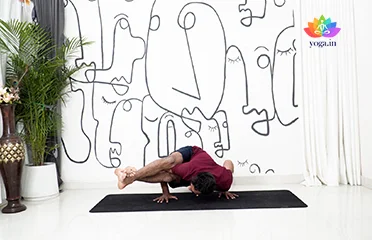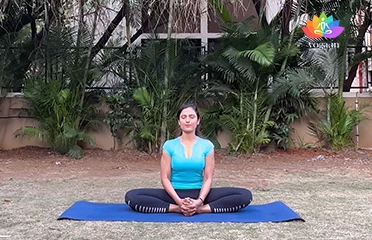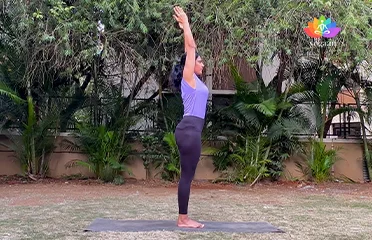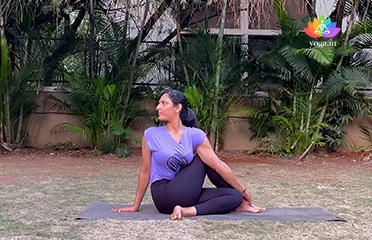Akarna Dhanurasana (Archer Pose)
अकर्णा धनुरासन / Archer Pose
The Sanskrit name is derived from Akarna (अकर्णा ) meaning towards [�K]
Anantasana (Sleeping Vishnu Pose)
अनन्तासन / Sleeping Vishnu Pose | Vishnu's Couch Pose
The Sanskrit name is derived from Ananta (अनन्त) meaning without end [�K]
Anjaneyasana (Crescent Moon Pose)
आंजनेयासन / Crescent Moon Pose
The Sanskrit name is derived from Anjane (आंजने) meaning Hanuman, [�K]
Astavakrasana (Eight-Angle Pose)
अष्टवक्रासन / Eight-Angle Pose
The sanskrit name is derived from ashta (अष्ट) meaning eight, Vakra [�K]
Bhadrasana (Gracious Pose | Butterfly Po
भद्रासन / Gracious Pose | Butterfly Pose
The Sanskrit name is derived from Bhadra (भद्रा) meaning gracious, [�K]
Bhujangasana (Cobra Pose)
भुजंगासन / Cobra Pose
The Sanskrit name is derived from Bhujanga (भुजंगा) meaning cobra [�K]
Hastapadasana (Hand to Foot Pose)
हस्तपदासन / Hand to Foot Pose
The sanskrit name is derived from hasta (हस्त) means hands, pada (पदा) [�K]
Kurmasana (Tortoise Pose)
कूर्मासन / Tortoise Pose
The Sanskrit name is derived from Kurma (कूर्मा) meaning tortoise [�K]
Matsyasana (Fish Pose)
मत्स्यासनI / Fish Pose
The Sanskrit name is derived from Matsya (मत्स्या) meaning fish [�K]
Matsyendrasana (Lord of the Fishes Pose)
मत्स्येन्द्रासन / Lord of the Fishes Pose
The name Matsyendrasana is derived from the Sanskrit words Matsya (मत्स्य) [�K]
- 1
- 2
How Yoga Can Help Cure Ovarian Issues:
The ovaries are a vital part of the female reproductive system, responsible for producing eggs and hormones like estrogen and progesterone. Yoga can help manage and alleviate various ovarian issues, including ovarian cysts, polycystic ovary syndrome (PCOS), and menstrual irregularities. Through specific postures, breathing exercises, and relaxation techniques, yoga can promote hormonal balance, reduce stress, and improve overall reproductive health.
Understanding Ovarian Issues:
Ovarian issues encompass a range of conditions affecting the ovaries, such as ovarian cysts, PCOS, and other hormonal imbalances. These conditions can lead to symptoms like irregular menstrual cycles, pelvic pain, and fertility problems. Understanding the nature and impact of these conditions is essential for effective management and treatment.
Yoga’s Role in Relieving Ovarian Issues:
Specific yoga practices can help alleviate the symptoms of ovarian issues by promoting hormonal balance, enhancing blood circulation to the pelvic area, and reducing stress. These include gentle asanas (postures) that stimulate the reproductive organs, pranayama (breathing exercises) that calm the mind and body, and meditation techniques that reduce stress and promote healing.
Key Factors Contributing to Ovarian Issues:
Several factors can contribute to the development of ovarian issues, including:
- Hormonal Imbalances: Irregular hormone levels can affect ovarian function.
- Insulin Resistance: Common in PCOS, affecting hormonal balance.
- Inflammation: Chronic inflammation can impact ovarian health.
- Genetics: Family history of ovarian issues increases risk.
- Lifestyle Factors: Poor diet, lack of exercise, and stress can contribute to ovarian problems.
Symptoms of Ovarian Issues:
Common symptoms of ovarian issues include:
- Irregular Menstrual Cycles: Menstrual periods that are infrequent, prolonged, or absent.
- Pelvic Pain: Persistent pain in the lower abdomen or pelvic region.
- Weight Gain: Unexplained weight gain, particularly around the abdomen.
- Acne and Skin Issues: Increased acne or oily skin due to hormonal changes.
- Hair Growth: Excessive hair growth on the face and body (hirsutism).
- Hair Thinning: Hair loss or thinning on the scalp.
- Fatigue: Persistent tiredness and lack of energy.
Treatment of Ovarian Issues through Yoga and Pranayama:
Yoga and pranayama can be highly effective in managing ovarian issues. Some beneficial practices include:
Specific Yoga Poses:
- Supta Baddha Konasana (Reclining Bound Angle Pose): Opens the hips and improves blood flow to the pelvic region.
- Setu Bandhasana (Bridge Pose): Stimulates abdominal organs and improves hormonal balance.
Pranayama Exercises:
- Nadi Shodhana (Alternate Nostril Breathing): Balances the mind and reduces stress.
- Bhramari (Bee Breath): Calms the mind and reduces stress levels.
Diet for Ovarian Issues:
A balanced diet can help manage ovarian issues. Recommendations include:
- Anti-Inflammatory Foods: Include foods like berries, leafy greens, and fatty fish to reduce inflammation.
- Whole Grains: Incorporate whole grains like oats and brown rice for better insulin regulation.
- Lean Proteins: Include lean meats, tofu, and legumes for essential nutrients.
- Healthy Fats: Avocados, nuts, and seeds support hormonal health.
- Hydration: Drink plenty of water to stay hydrated and support overall health.
Caution for Ovarian Issues:
While practicing yoga for ovarian issues, it is essential to:
- Avoid Overexertion: Practice at a gentle pace to prevent strain on the body.
- Be Mindful of Pain: Stop immediately if any pose causes discomfort or pain.
Always consult with a healthcare provider before starting any new exercise regimen, especially if you have severe ovarian issues.
Contraindications for Ovarian Issues:
Individuals with severe ovarian issues or significant pelvic pain should:
- Avoid Intense Yoga Practices: Vigorous exercises might exacerbate symptoms.
- Steer Clear of Certain Poses: Inversions and poses that compress the abdomen may increase discomfort.
- Seek Professional Guidance: Consult a yoga therapist or healthcare professional for personalized recommendations.











